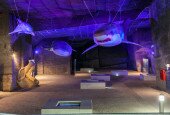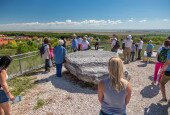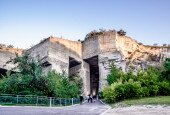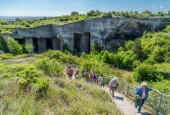Fertőrákos Cave Theater and Quarry Thematic Park
The rock block of the Quarry in Fertőrákos, with its cave-like halls formed over the past nearly two thousand years is an exhibition site and event venue with a special atmosphere.
The quarry (cave) area is a multifunctional space, in which the exhibition is divided into two major units: a paleontological presentation about the conditions of the formation of the Lajta limestone produced in the area, and another unit showing the utilization of the limestone. Within this, taking into account the natural spatial features of the cave, the two main areas can be divided into further units:
I. Formation of the Lajta Limestone - Miocene (Baden) marine habitats: 1. Introduction / 2. Time Tunnel / 3. Miocene Sea Hall. Underground "education trail"
II. Utilization of the Lajta Limestone: 4. Stone Mining Hall / 5. Stone Carving Hall
I./1. Introduction: The area around the Sopron Mountains, including the Fertőrákos quarry was covered by a shallow sea during the Middle Miocene (Baden), from the sediment of which the Lajta Limestone rich in fossils was formed.
I./2. Time Tunnel: We reach the depths of the ancient sea through a 22-meter long "time tunnel".
I./3. Miocene Sea Hall: the life of the Miocene Sea comes to life; the most spectacular elements here are the life-size ancient whale, shark and dolphin reconstructions hanging above the visitors’ head.
II./1. Stone Mining Hall: Excavation in the quarry in Fertőrákos started in Roman times. Stone mining ended in 1948. In this exhibition unit, visitors can get acquainted with the tools of mining, the method of quarrying, its history and related professions.
The 4-ton stone blocks were towed by 8-12 pairs of buffaloes from Fertőrákos to Vienna in a month, where the limestone was used for the decorated facades of several buildings in the imperial city.
II./2. Stone Carving Hall: The Lajta limestone is easy to carve and it is frost-resistant, so it became a popular building stone and was used at many construction sites in the area including Sopron and Vienna.
Sziklai Benge educational trail: Walking along the trail on the quarry, visitors can see the natural values of the Fertőákos quarry, the Lake Fertő area and the Fertő-Hanság National Park. With the help of the thematic demonstration sites created at the lookout points, you can get to know the protected plant and animal species living in the nature reserve, and you can also enjoy a wonderful view of Lake Fertő and the Pan-European Picnic site.
Fertőrákos Cave Theatre: Ernő Dohnányi, the famous composer, conductor, pianist and teacher was the first to realise that this venue is excellent for organizing outdoor concerts. On 27 June 1937, opera music was played in the Quarry at the light of torches and the scenery was completed with the quarry's rock block, night sky and stars.
The weather posed the greatest risk to the outdoor performances, so plans were made to use the quarry’s excavated halls as theatre hall. The founder of the Cave Theater is György Várady, the former director of the Kisfaludy Theatre in Győr. The first performance in the hall with great acoustics was held on 27 June 1970. The Cave Theatre was completely renovated in 2015, and it is open to visitors with an expanded auditorium and stage.
INFORMATION ABOUT THE TICKETS: https://www.fertorakosikofejto.hu/en/tickets
The Miocene Theme Park welcomes its guests from April 3, 2026.
Opening hours: every day 10 am - 6 p.m.
+36 99 530 404
+36 99 517 517






